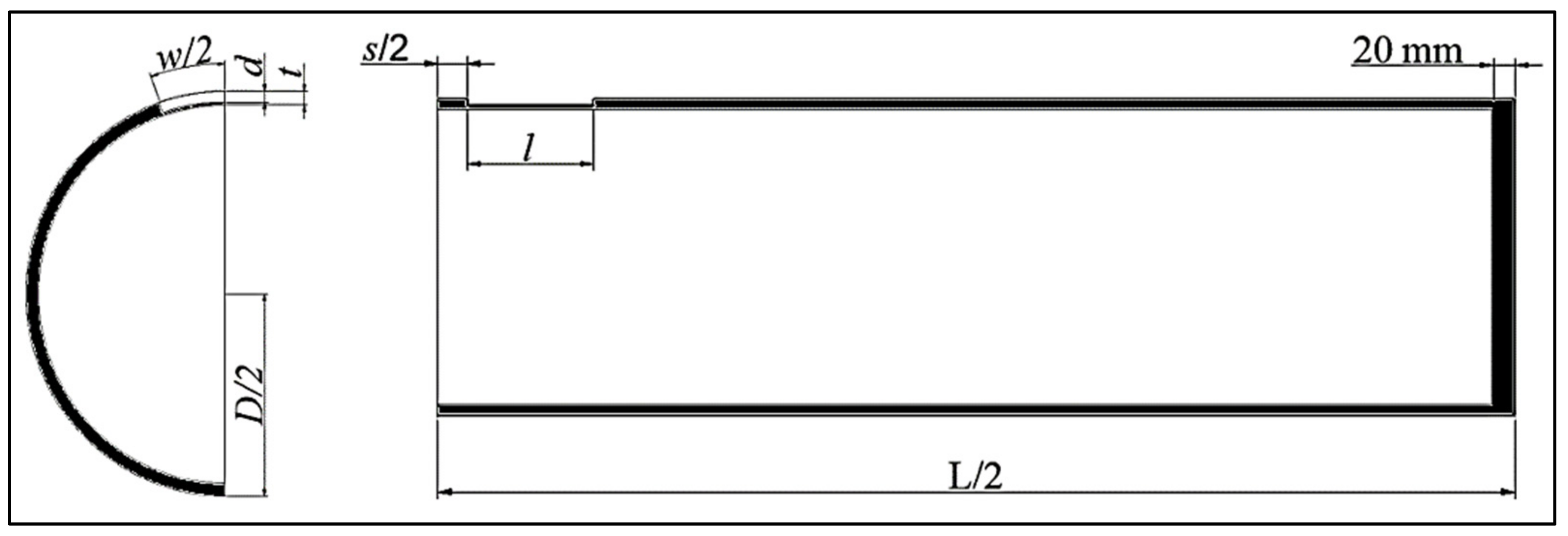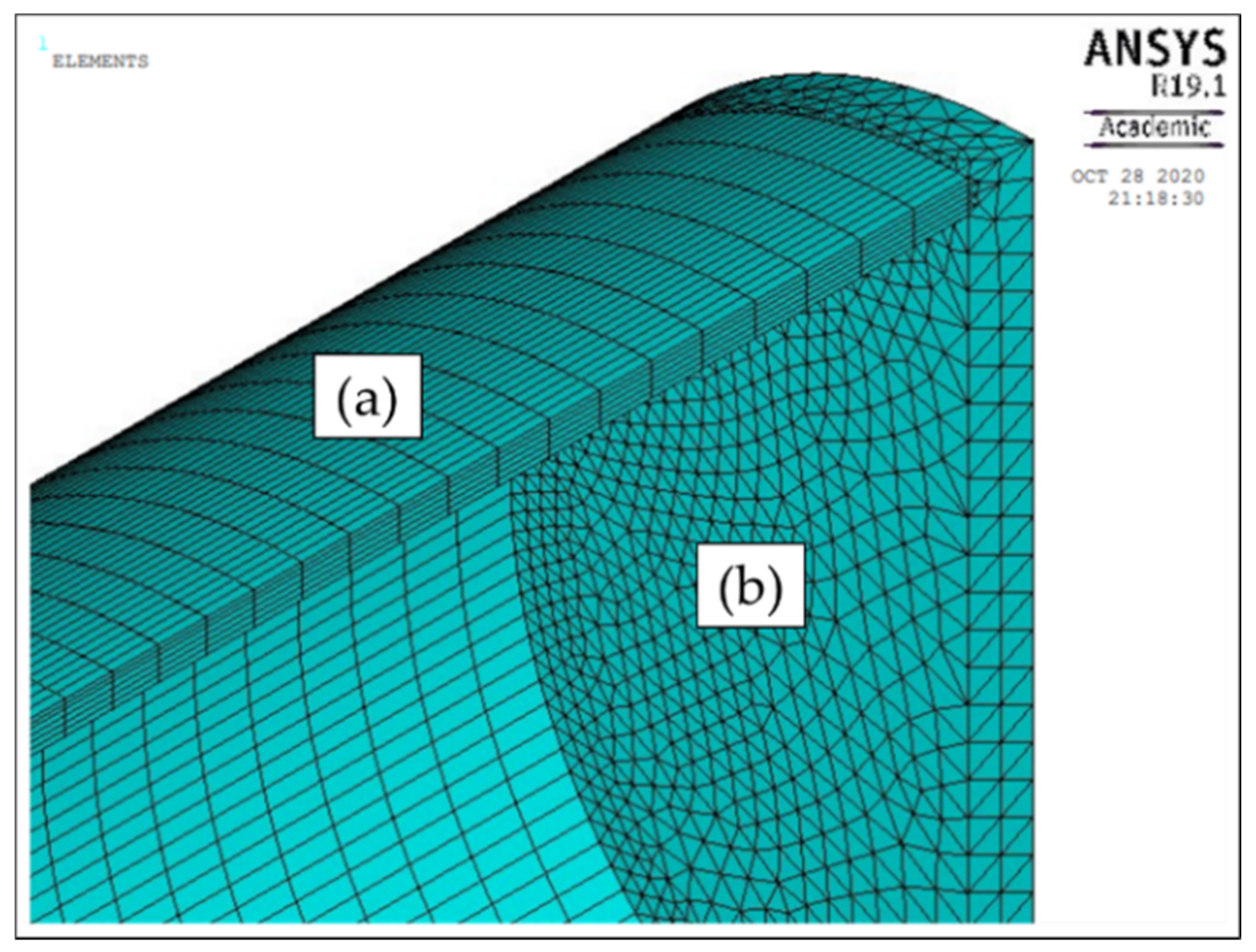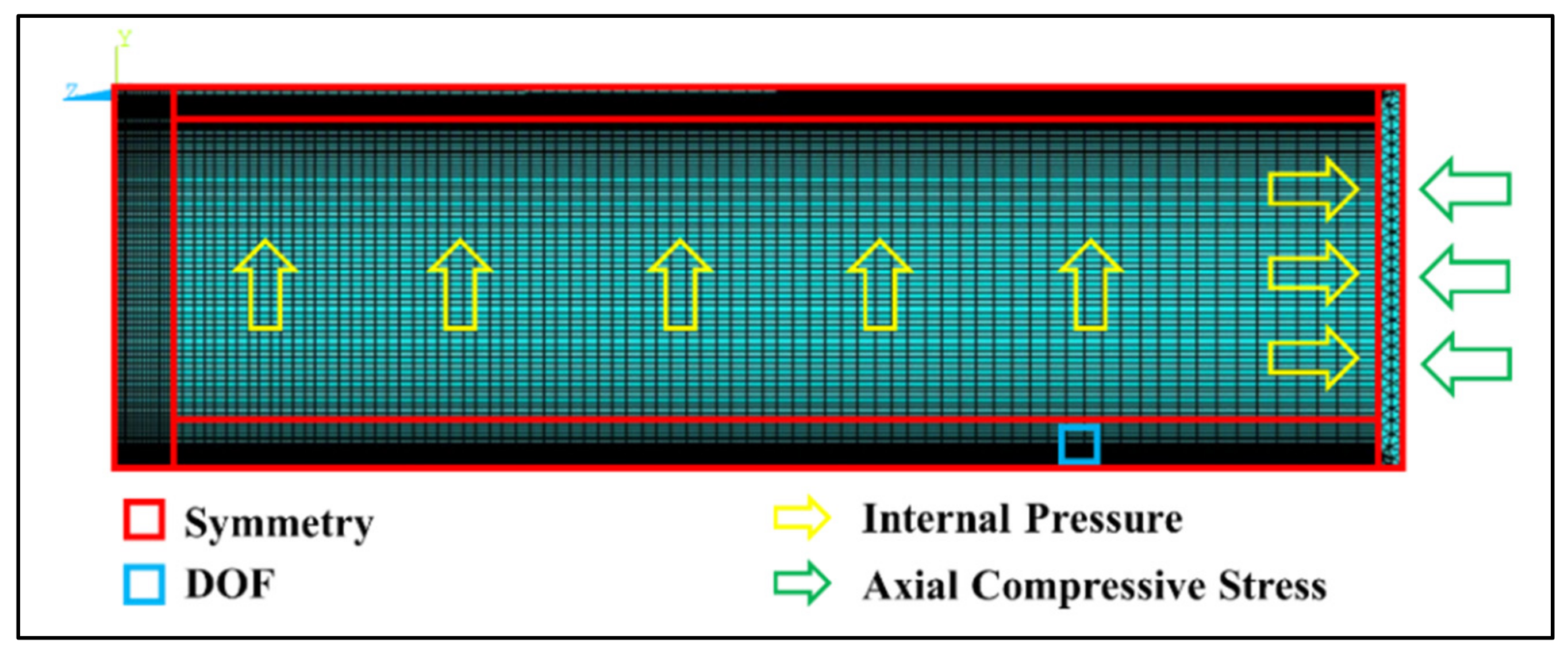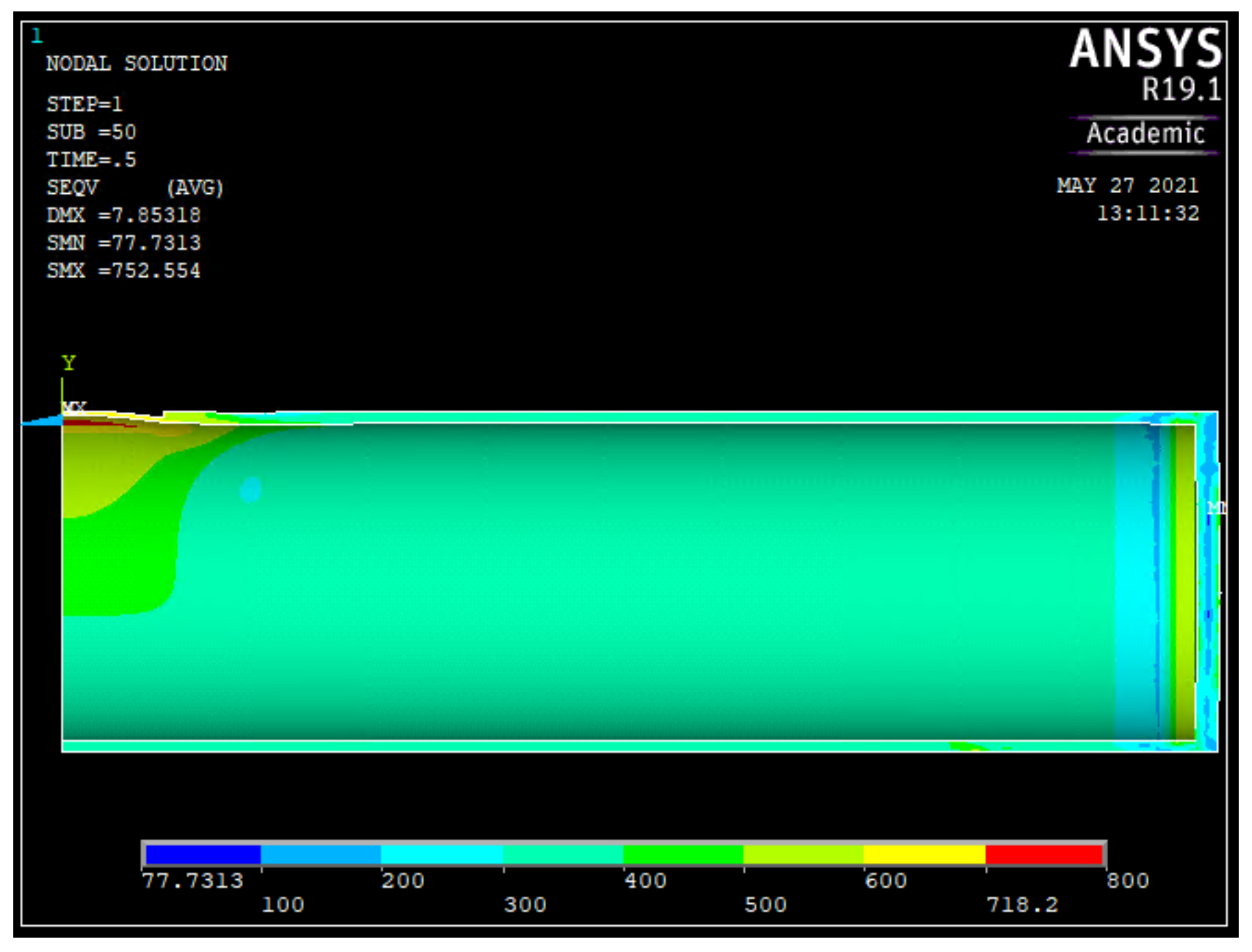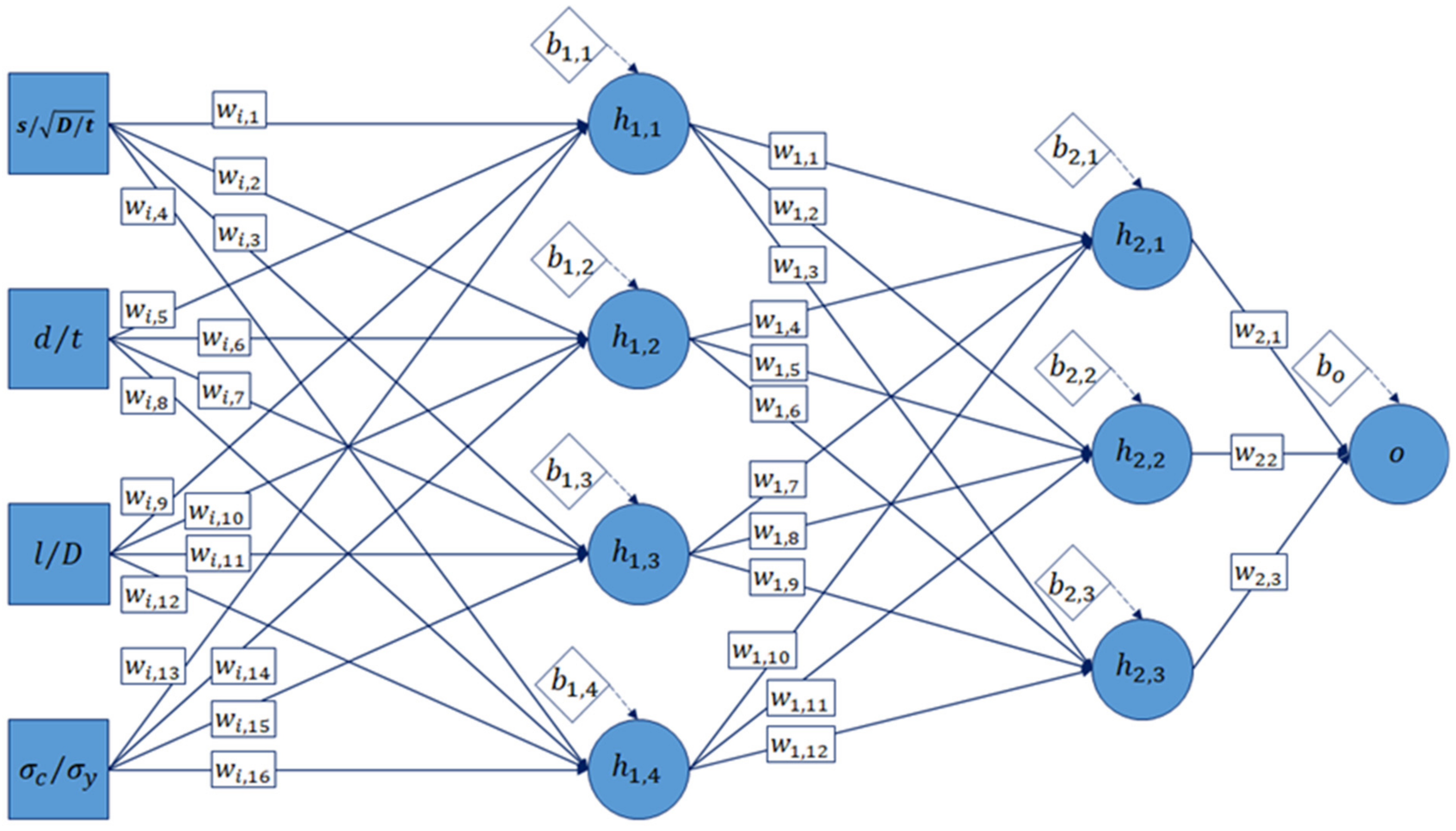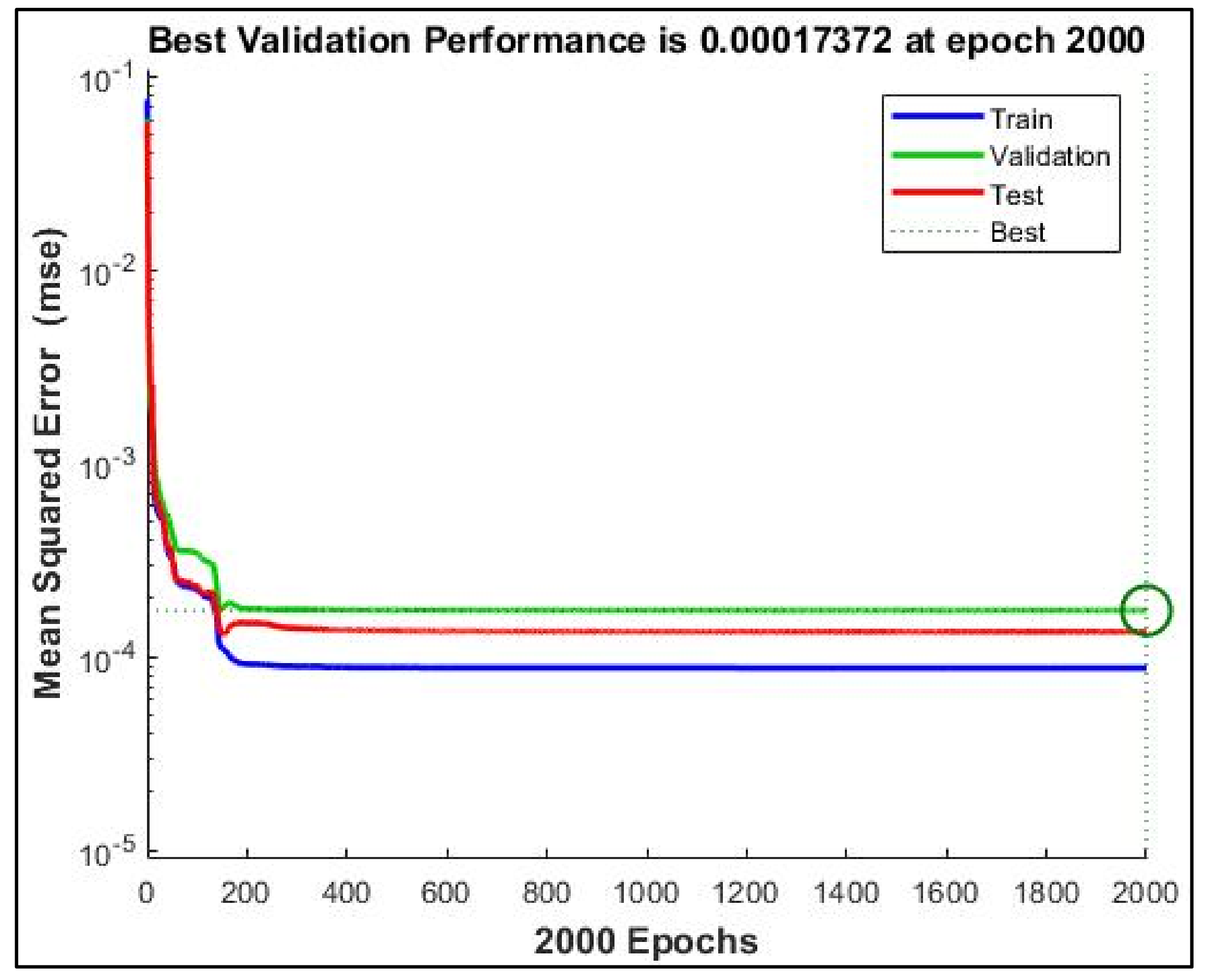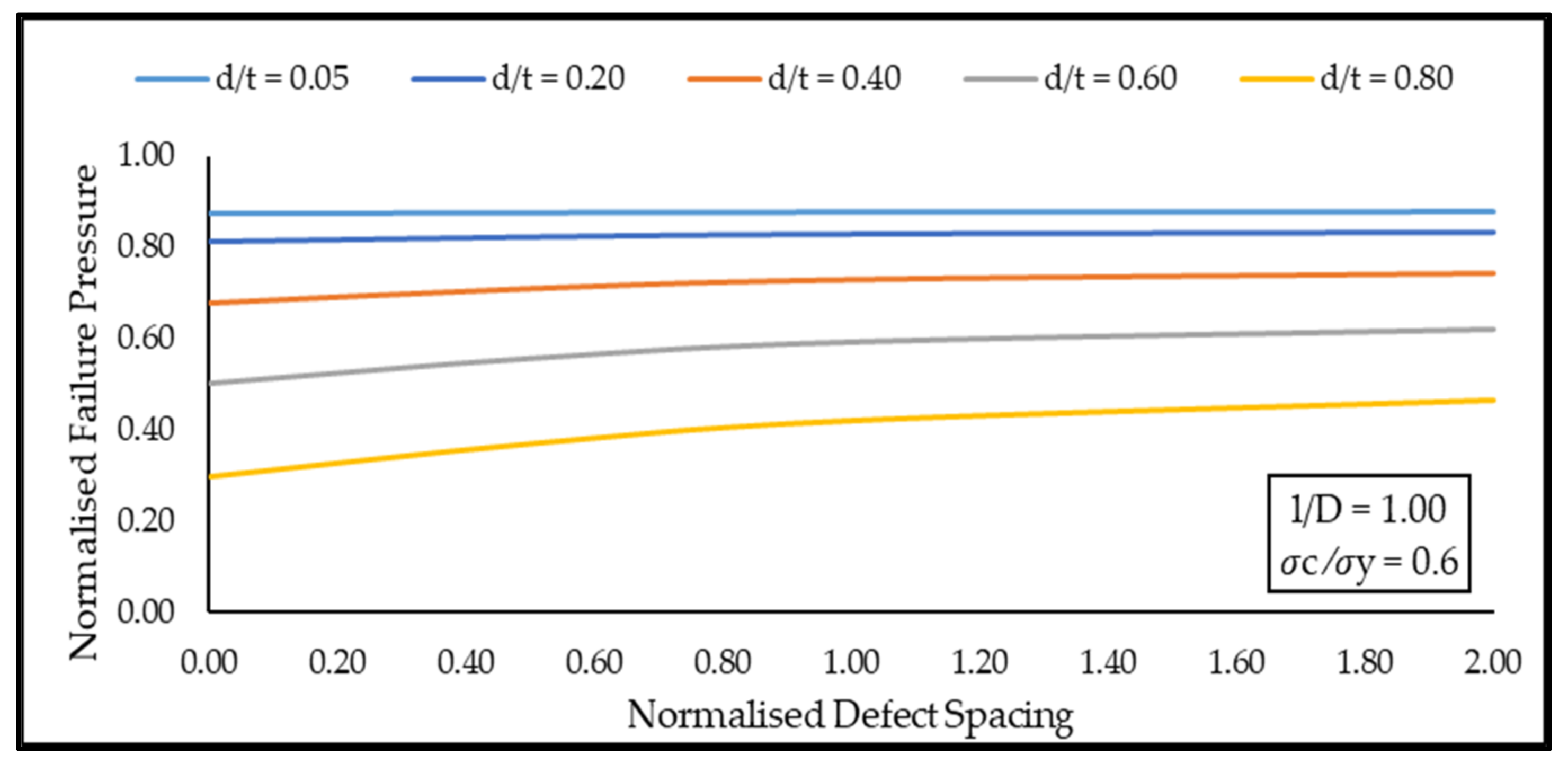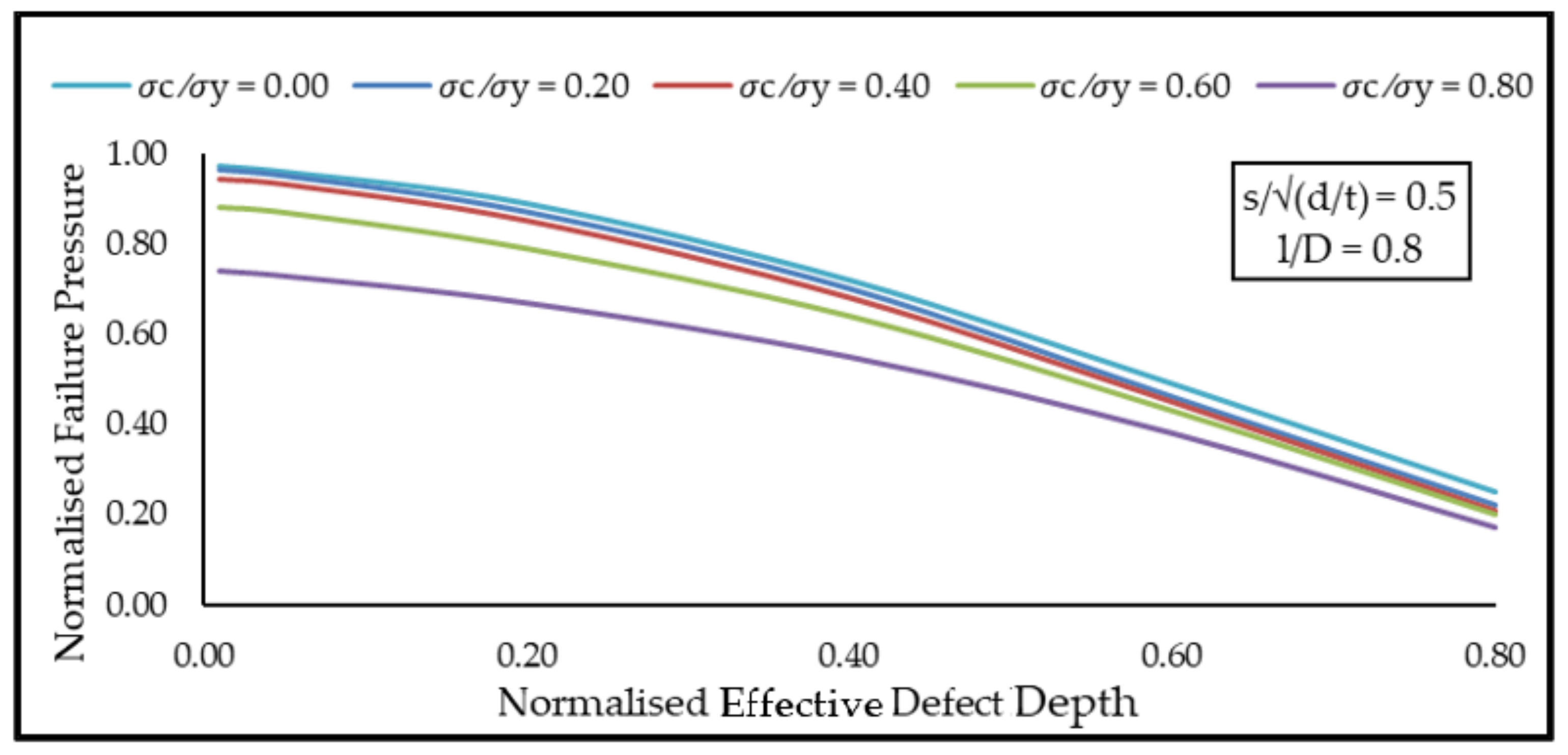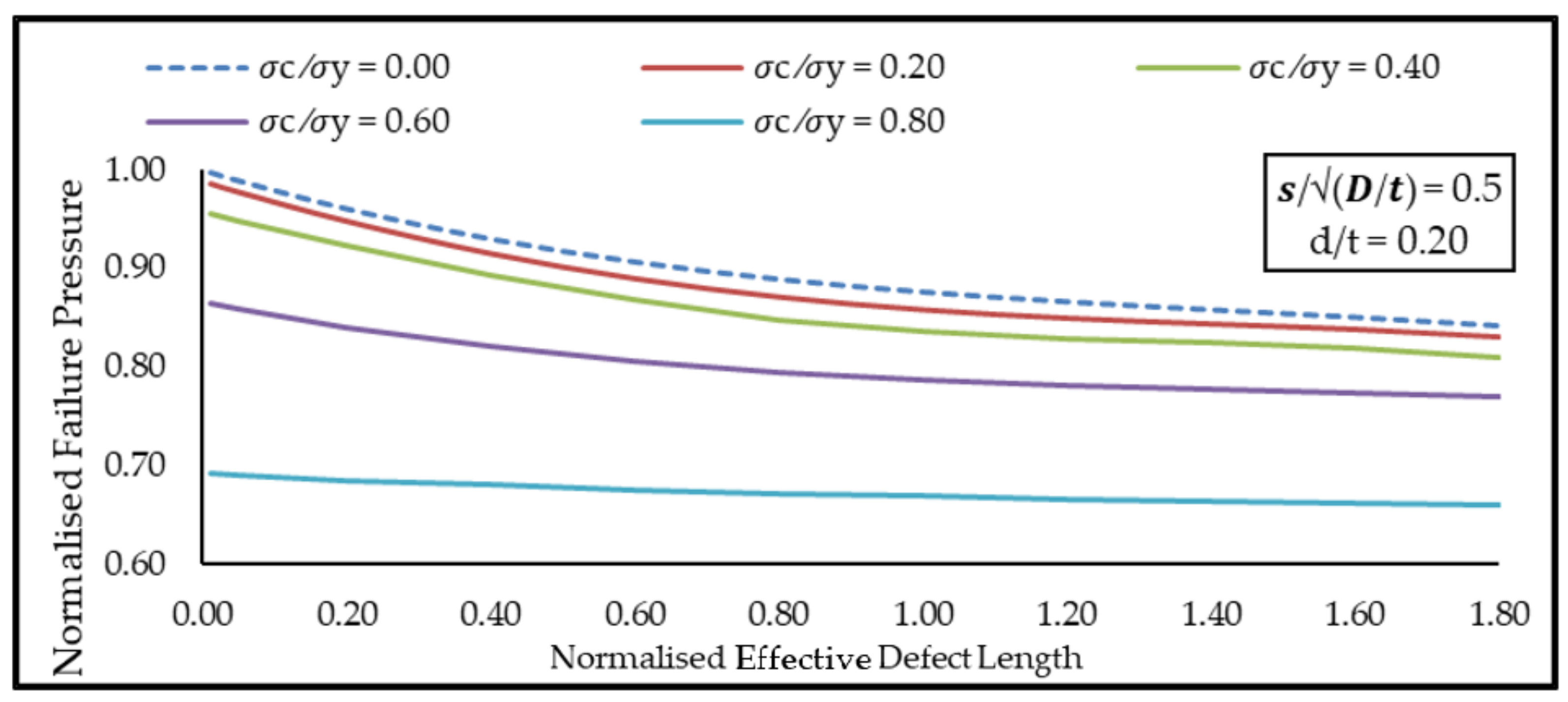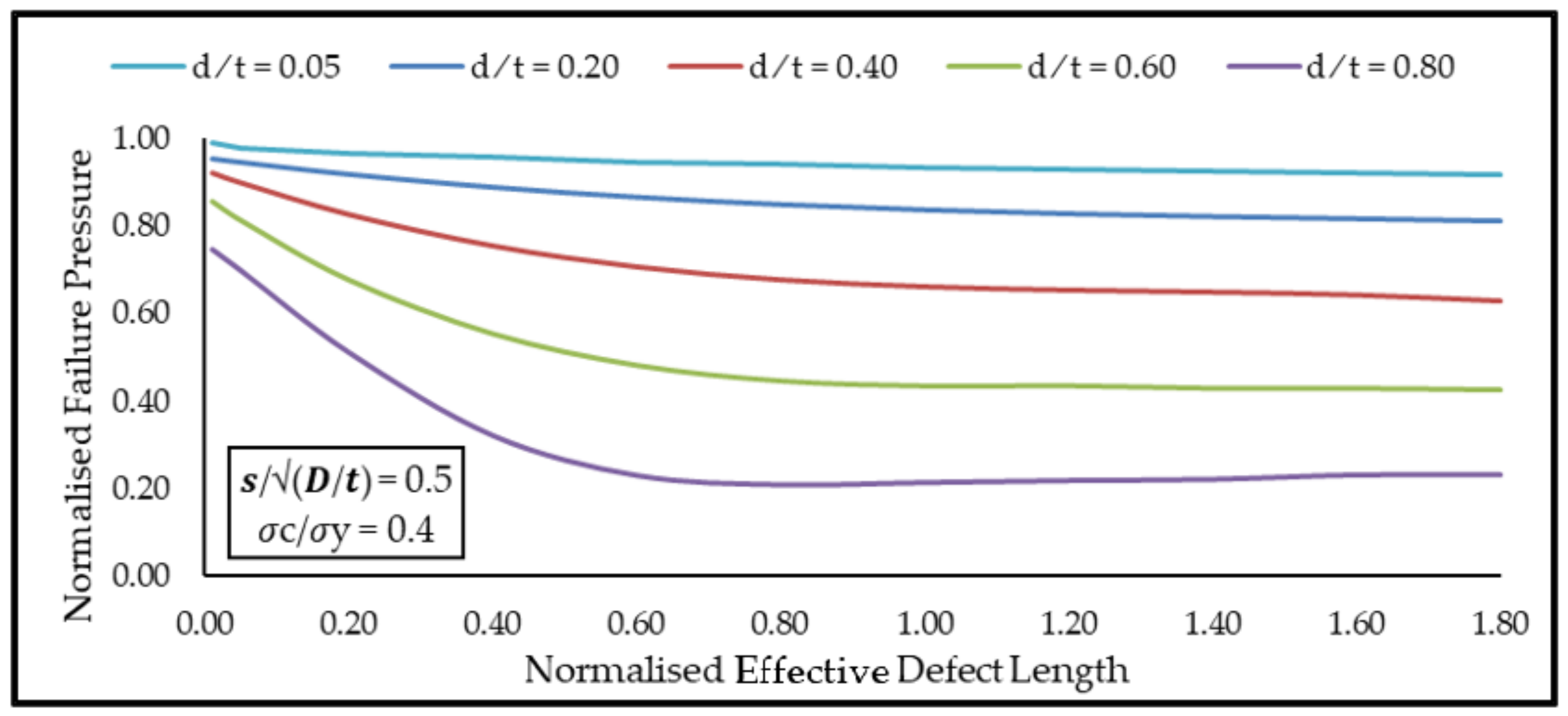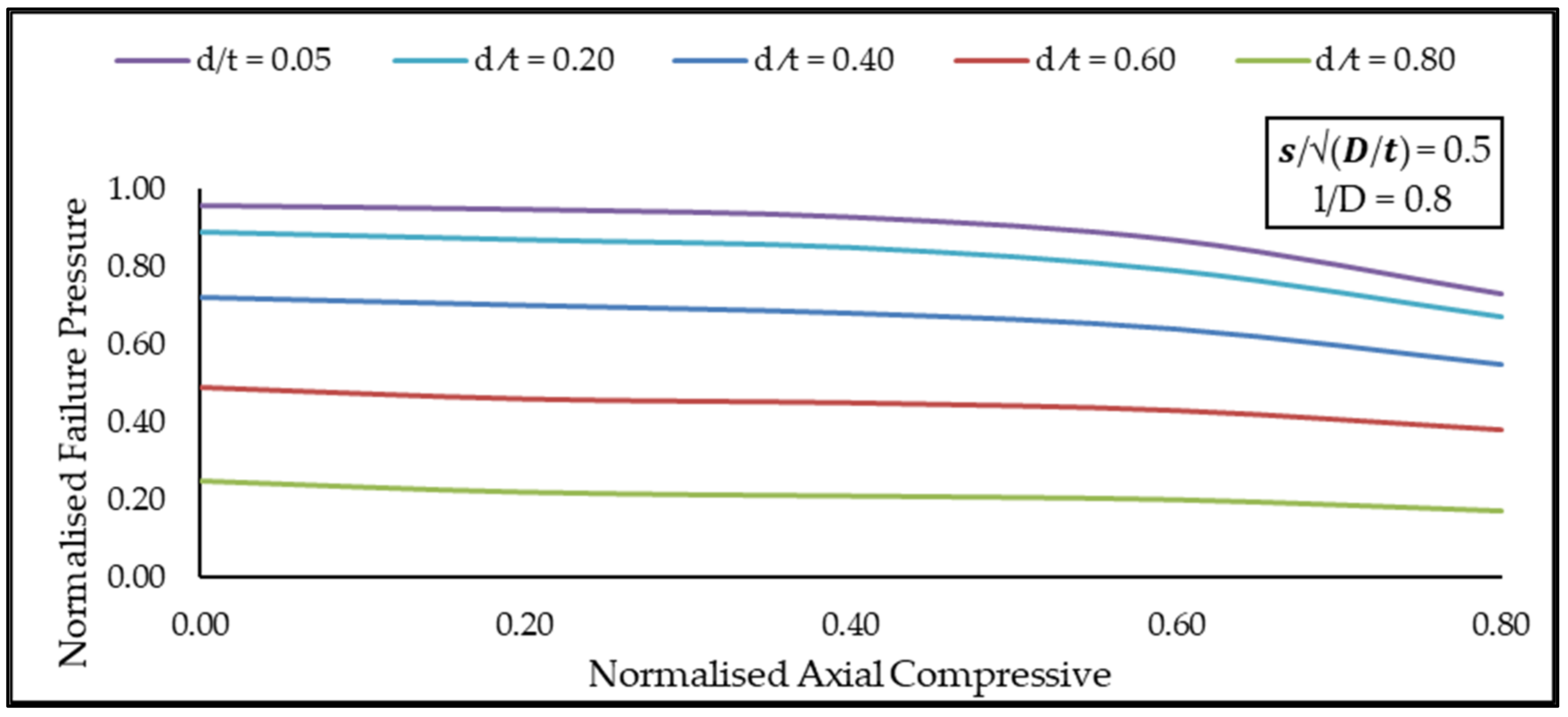1.1. Overview of Pipelines in the Oil and Gas Industry
Pipelines are widely utilized for upstream oil and gas operations for the transportation of hydrocarbon from the reservoir to onshore processing facilities. On average, a pipeline stretches across hundreds of kilometers, operating at high pressures and temperatures. This harsh environment results in pipe wall degradation, also known as corrosion [
1]. In a pristine pipe, the hoop stress is distributed evenly throughout the pipe. However, in the presence of corrosion defects, the hoop stress distribution is nonuniform [
2,
3,
4].
When fluid flows through a pipeline, internal pressure is exerted on the pipe wall causing circumferential expansion which results in the contraction of the pipe in the longitudinal direction due to Poisson’s effect [
5,
6,
7]. This condition subjects the pipeline to axial compressive stress. Strain builds up at the region of defect, making it the most critical region in the pipeline [
8,
9]. In the region of defect, the deepest defect experiences the highest stress. When the stress exceeds the true ultimate tensile strength of the pipe, the pipe fails prematurely. The failure pressure of a pipeline is significantly influenced by the length and depth of the corrosion defect when subjected to axial compressive stress [
10,
11,
12], especially in the presence of interacting defects. It is therefore crucial that the integrity of a pipeline is assessed periodically to ensure a safe and efficient operation.
1.2. Pipeline Integrity Assessment Methods
Developing a corrosion assessment method that is applicable for all types of corrosion defects as well as pipeline grades is challenging due to the complexity of the corrosion defect geometry and differences in tensile properties of materials [
13,
14,
15,
16,
17]. As such, different assessment methods are used for different scenarios. Furthermore, various assumptions are made to simplify the assessment. As such, the failure pressure prediction of a pipe for each corrosion assessment method differs due to these simplifications.
By redefining the Folias factor and flow stress equations of the ASME B31G method, the Modified ASME B31G method was developed. In this method, an arbitrary shape correction factor is applied instead of the parabolic area assumption. This enables the method to be applied to corrosion defects that are longer than the limits given in the ASME B31G method. The SHELL 92 method also utilizes the same Folias factor as the ASME B31G method. However, this method produces predictions that are relatively conservative due to the flow stress assumption of the method [
16].
The RSTRENG method, also known as the effective area method, is used in assessing defects up to 0.8 t. This method represents the corrosion defect region with a river bottom profile that enables failure pressure prediction with greater accuracy using the discrete method [
16,
18]. The Pipe Corrosion Criterion (PCORRC) method is based on a finite element study that was validated using burst test results.
The ASME B31G, Modified B31G, SHELL 92, and RSTRENG methods were developed based on the NG-18 as the fundamental equation. In these methods, it is assumed that the tensile property of a pipe material determines the pipe failure mechanism [
2,
14,
15]. However, the governing assumption of the DNV-RP-F101 code, which was also developed based on the NG-18 equation, is that the failure of the pipe is due to plastic collapse (plastic flow), where the ultimate tensile strength is the flow stress. This governing assumption is also applied to the PCORRC method that was developed based on numerical studies. In all these methods, the corrosion depth and longitudinal length are considered and are independent of the width of the corrosion. The conservatism in these methods due to the assumptions, simplifications, and safety factor leads to unwarranted repairs and premature replacement of a pipeline, incurring unnecessary costs [
9,
19].
For pipes subjected to internal pressure and axial compressive stress, the DNV corrosion assessment code is the most comprehensive code [
2]. The DNV code allows for failure pressure prediction of single and interacting corrosion defects subjected to internal pressure only, and single defects subjected to internal pressure and axial compressive stress [
15]. The DNV code has been compared against actual full scale burst pressure tests for medium toughness pipes with material grades ranging from API 5L X42 to API 5L X65. Nevertheless, the failure pressure predictions based on this code are conservative. This conservatism is primarily due to the use of the ultimate tensile strength,
σUTS, rather than the true ultimate tensile strength,
σ×
UTS, of the material [
9], since the rupture point of a material is represented by the true ultimate tensile strength of the material [
2].
As this method is developed for medium toughness pipes, utilizing it for high toughness pipes may result in inaccurate failure pressure predictions [
9]. Hence, an alternative failure pressure prediction method is necessary to overcome the limitations of this failure pressure assessment method, which are summarized in the points below:
The DNV code does not incorporate axial compressive stress for the failure pressure assessment of interacting corrosion defects.
The DNV code results in conservative failure pressure predictions.
The DNV code results in inaccurate failure pressure predictions for high toughness pipes.
1.3. Finite Element Method (FEM) for Pipeline Failure Pressure Prediction
Due to the limitations of the assessment codes, numerical methods are utilized. The American Society of Mechanical Engineers categorized numerical methods such as FEM as a Level 3 assessment method, which is considered to be the most advanced assessment level [
14]. FEM considers the uniaxial true stress-strain curve of a material, important for structures that change in geometry due to large displacements. As the pipe undergoes deformation, the equilibrium equations take into consideration the geometrical changes of the pipe as well as the nonlinear stress-strain relationship of the material. Strain hardening as well as elastic and plastic deformation of the material is accounted for in the assessment process, resulting in good failure pressure prediction [
3].
The complex geometries of corrosion defects are often idealized as simple shapes in FEM for ease of assessment. The most common idealized defect shapes are rectangular, elliptical, parabolic, and in some cases conical shape [
19,
20,
21,
22]. Wang et al. [
23] investigated the failure pressure difference between finite element models with rectangular defect and elliptical defect. The study found that there is an insignificant difference in failure pressure prediction between the two idealized defects. Conventional standards, such as the DNV code, commonly idealize corrosion defects as rectangular-shaped defects [
13,
15,
24].
However, the accuracy of the failure pressures obtained using FEM is highly dependent on the proper choice of boundary conditions, material properties, and model features [
21]. The meshing size of the model also plays an important role in the accuracy of the results. Smaller meshes result in high accuracy but consume longer simulation time. Hence, the modeling of the pipe has to be optimized to reduce simulation time without compromising the accuracy of the results [
25]. The FEM results will be erroneous if any of the components are poorly defined, resulting in wrong failure pressure predictions. Hence, the FEM needs to be validated against actual burst test. This process can be very time consuming, especially when it involves the incorporation of axial compressive stress.
Even if the FEM is correct, it is computationally expensive. Many researchers apply the eXtended Finite Element Method (XFEM) in their studies to overcome the limitations of FEM in the field of fracture mechanics. Since damage mechanics is mesh dependent, XFEM allows pipeline failure prediction under various loading conditions without refining the mesh closer to the region of interest [
26]. Using this approach, the mesh conformance of crack geometry is avoided [
27]. Okodi et al. investigated the potential of XFEM to be used in crack propagation analysis and burst pressure prediction of pipelines [
28]. It was found that XFEM can be effective in carrying out crack propagation analysis, as well as predicting pipeline burst pressure, but it was recommended that further parametric studies be done to come to a firm conclusion. Their study was further supported by Zhang et al., who investigated the failure pressure prediction of cracks in corrosion defects [
29]. It was concluded that XFEM is useful for crack propagation analysis, whereby if FEM was applied, it would require extremely fine meshes. Hence, XFEM is suitable for problems with interior boundaries, discontinuities, or singularities because of the need of remeshing and high mesh densities [
30]. In predicting the failure pressure of corroded pipelines using a stress-based von Mises criterion, the entire surface of the model coincides with the edge of the FEA [
2,
9,
31,
32]. In such cases, FEM is adequate [
30].
FEM is widely utilized to analyze the stress distribution across pipes and identify the pressure at which the point of failure occurs for corroded pipelines. Colindres et al. investigated the effects of internal and external corrosion defects using the stress-based von Mises criterion using FEM. In their paper, they recommended FEM be utilized for complex corrosion defect cases in pipelines [
31]. To reduce the computation time, quarter models are usually utilized with symmetric boundary conditions that treat the pipe as a whole during simulation. Despite this, a single simulation run can take hours to complete. As such, using FEM for the failure pressure prediction of multiple corroded pipelines subjected to internal pressure and axial compressive stress is not practical, especially in time critical situations.
To overcome this, a simple empirical solution with wide applicability, as an alternative to the DNV-RP-F101 equations, that is as accurate as a Level 3 assessment method is proposed. However, there is a nonlinear relationship between the geometry of a defect and axial compressive stress with the failure pressure of the corroded pipe [
9]. The defect length, defect depth, and amount of axial compressive stress imposed on the pipe can occur in various combinations. As such, it is not trivial to develop the empirical equation, as large data will be required to analyze this nonlinear relationship. As such, this nonlinearity can be analyzed using FEM simulation and the data could be used to validate the equation [
32].
An empirical equation, based on the weights and biases of an ANN trained using results from FEA, can be used to provide failure pressure predictions within seconds. Xu et al. [
33] utilized FEA to generate training data for the development of an ANN to predict the failure pressure of a corroded pipe with a relative error percentage of less than 1%. A parametric study was conducted, and the data were used to train an ANN. There was an insignificant error between the experimental values and results obtained from the trained ANN. This approach was also followed by Lu and Liang [
34], and Gholami et al. [
35], who studied the effects of defect geometry on the failure pressure of a corroded pipe using FEM and used the data to train an ANN model. As such, FEM is a reliable method for obtaining training data for the development of an ANN. Based on the weights and biases of the trained ANN, an empirical equation can be developed with ease.
1.4. Artificial Neural Network (ANN) as a Pipeline Failure Pressure Assessment Method
Gurney [
36] defined an ANN as an interconnected assembly of simple processing elements called nodes and the processing ability of the network is stored in the interunit connection strengths called weights which are obtained by learning a set of training patterns. A neural network mimics the synapses in a human brain by employing weights and biases to neurons in hidden layers of the neural network and reinitializes them until the neural network produces accurate results [
37]. When this is achieved, the neural network is said to be trained. It is crucial that the training dataset consists of a sufficient number of inputs and corresponding outputs to minimize the error in the output of the neural network [
38,
39,
40].
An ANN has the ability to learn, recognize, and infer from complex nonlinear data without requiring an explicit set of instruction [
40,
41]. A set of data that consists of one or more inputs and outputs is analyzed by the neural network using specific algorithms depending on the ANN type and purpose. An ANN is capable of learning directly from a set of training data, and regaining as well as extracting information from noisy data is one of the most important properties of it that has been proven to be very useful in the field of mechanical failure analysis [
41].
Various studies on fracture toughness and fracture parameters utilizing ANN have been carried out by many researchers and this approach has shown promising results. A trained ANN was able to produce results that were very close to the training data fed to the ANN with an acceptable accuracy [
41]. Furthermore, an ANN does not require simplifications or assumptions to process and learn from the training data. Moreover, the study conducted by Ince [
42] to predict the fracture parameters of concrete using ANN proved that ANNs can also be utilized to carry out parametric studies.
The architecture of an ANN also depends on the type of data and desired output. Among the commonly used ANN architectures, a Feed Forward Neural Network (FFNN) is mostly utilized in predicting the failure pressure of corroded pipelines. This type of neural network paired with back propagation supervised learning algorithm is typically utilized as it examines the training data and generates an inferred function that can be applied to new scenarios [
43,
44,
45]. This type of ANN architecture is modeled to learn from paired datasets where the model learns from one or more inputs and the corresponding output of the training dataset.
The utilization of ANN in the field of failure pressure assessment has improved over the years, resulting in more practical applications. In early applications of ANN, researchers took into account the physical, mechanical, operational, and environmental factors that influenced the residual strength of a pipeline [
46]. However, obtaining a large training dataset for such cases is challenging. Shirzad et al. [
47] and Senouci et al. [
48] emphasized in their paper that an ANN model with a reasonable accuracy and robustness cannot be achieved with the lack of real-life data. Xu et al. conducted parametric studies using FEM to generate a training dataset for an ANN model to accurately predict the failure pressure of a high toughness pipe with a relative error of less than 2% [
33]. Their results were supported by Lu and Liang [
34] and Gholami et al. [
35], who developed an ANN model based on data generated from FEA. It was proven that an ANN is highly capable of predicting the failure pressure of a corroded pipeline accurately.
This study aims to establish a correlation between defect geometries and failure pressure of high toughness corroded pipelines and develop an empirical corrosion assessment method for the failure prediction of high toughness corroded pipelines subjected to internal pressure and axial compressive stress. The empirical equation was developed based on the weights and biases of an ANN trained with values from parametric studies utilizing FEA. The equation was then validated against FE models with single defect corrosion and full-scale burst tests.
